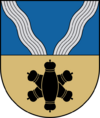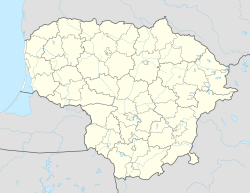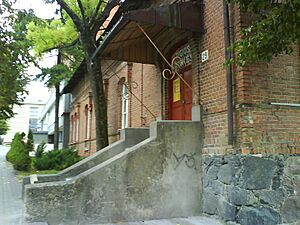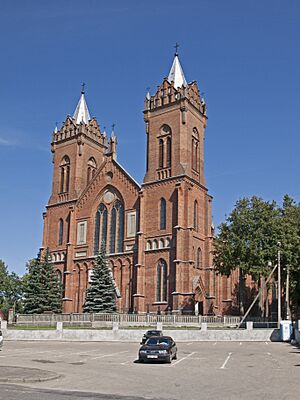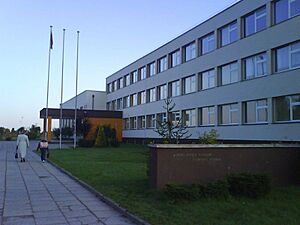Kupiškis facts for kids
Quick facts for kids
Kupiškis
|
|||
|---|---|---|---|
|
Town
|
|||
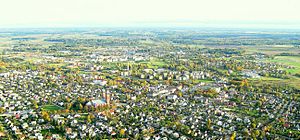
Town view from northwest
|
|||
|
|||
| Country | |||
| County | |||
| Municipality | Kupiškis district municipality | ||
| Eldership | Kupiškis eldership | ||
| Capital of | Kupiškis district municipality Kupiškis eldership |
||
| First mentioned | 1460 | ||
| Granted town rights | 1791 | ||
| Population
(2022)
|
|||
| • Total | 6,138 | ||
| Time zone | UTC+2 (EET) | ||
| • Summer (DST) | UTC+3 (EEST) | ||
Kupiškis () is a town in northeastern Lithuania. It is the main town of the Kupiškis district municipality. Kupiškis is famous for its sculptures and a large water reservoir, which is the fourth biggest in Lithuania.
The town is located where the Lėvuo and Kupa rivers meet. The name Kupiškis comes from the Kupa River. The Gediminas Bridge crosses the Kupa River.
Kupiškis has six main parts:
- Centras (Center or Old Town): This is the oldest part of town. It has the town hall, library, church, and high school. You'll find both apartment buildings and detached houses here.
- Krantinė: This area has many apartment buildings (4-5 floors), detached houses, shopping centers, and schools.
- Kraštiečiai: Here you'll see apartment buildings (2-6 floors), shopping centers, and a preschool.
- Račiupėnai: This is a residential area with detached houses. It also has a middle school, a business and technology school, and the bus station.
- Zuntė: This is another residential area with detached houses.
- Pramoninė teritorija (Industrial district): This part of town has factories, warehouses, and the train station.
Contents
History of Kupiškis
Archaeologists have found signs that people lived around Kupiškis as early as the 3rd and 2nd centuries BC. We don't know exactly when the town itself was founded. Findings near the Aukštupėnai mound show that a wooden defense castle stood there in the 8th century.
Early Mentions and Growth
Kupiškis was first mentioned in historical records in 1529. At that time, it belonged to Sigismund I the Old, who was the ruler of the Grand Duchy of Lithuania. From 1561 to 1565, Kupiškis was an important local center. The main road connecting Vilnius to Riga passed through Kupiškis.
In 1616, the first Catholic church was built in Kupiškis. Later, in 1781, the first school was opened by the Lankasteriai family. A railway line was built through Kupiškis in 1873, connecting Daugavpils to Šiauliai and Liepāja.
Population of Kupiškis
As of January 1, 2005, Kupiškis had a population of 8,243 people. Most people living in the Kupiškis district municipality are Lithuanians.
Jewish Community in Kupiškis
Before World War II, Kupiškis was home to a large Jewish community. They made up about 42% of the town's population in 1939. During the summer of 1941, the Jewish people in Kupiškis faced terrible events. They were forced into a small area, suffered greatly, and were later taken to a cemetery where many lost their lives.
After the war, lists were made to remember those who died. Today, the former Great Synagogue building in Kupiškis serves as a public library. Inside, there is a "Wall of Memory Holocaust Memorial." This memorial was put up on July 13, 2004. It helps people remember the Jewish community that once thrived in Kupiškis. Jewish descendants of the town's residents held a special service there, the first since 1941.
Educational Institutions
Kupiškis has several schools for different age groups.
Schools for Older Students
- Kupiškis Laurynas Stuoka-Gucevičius gymnasium: This is a high school for students aged 14 to 18.
- Kupiškis Povilas Matulionis progymnasium: This school is for younger students, from 6 to 14 years old.
- Kupiškis Technological And Business School: This school offers training for students aged 16 to 21.
Art and Preschools
- Kupiškis Arts School: Here, students can learn about different types of art.
There are also several preschools for very young children:
- Varpelis
- Obelėlė
- Saulutė
Sports in Kupiškis
Kupiškis has a football club called FC Kupiškis. The town also has the Kupiškio centrinis stadionas, which is a central stadium for sports.
Twin Towns
Kupiškis has special partnerships with other towns around the world. These are called twin towns or sister cities. They work together to share culture and ideas.
Notable People from Kupiškis
- Laurynas Gucevičius: He was a famous Polish-Lithuanian architect. He was born in a village called Migonys near Kupiškis.
- Jonas Černius: He was a former prime minister of Lithuania. He was born right in Kupiškis.



